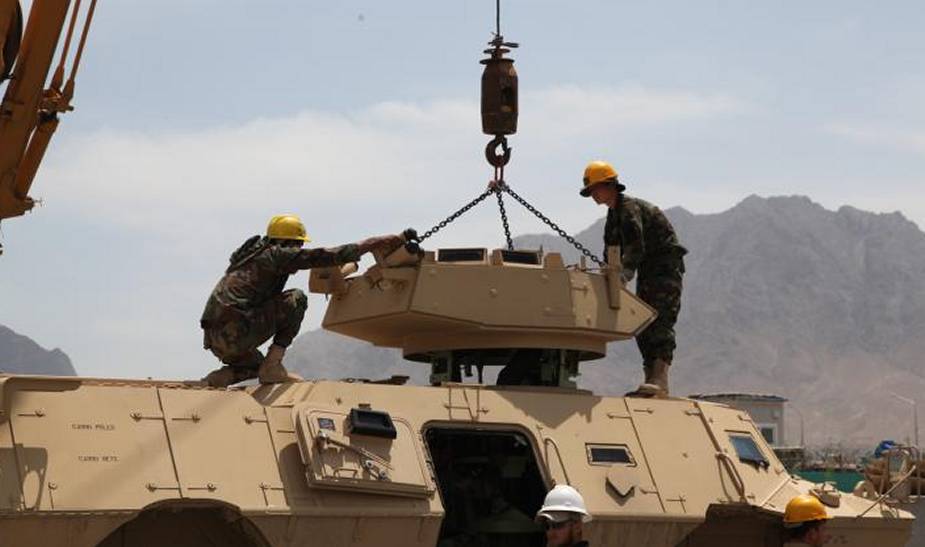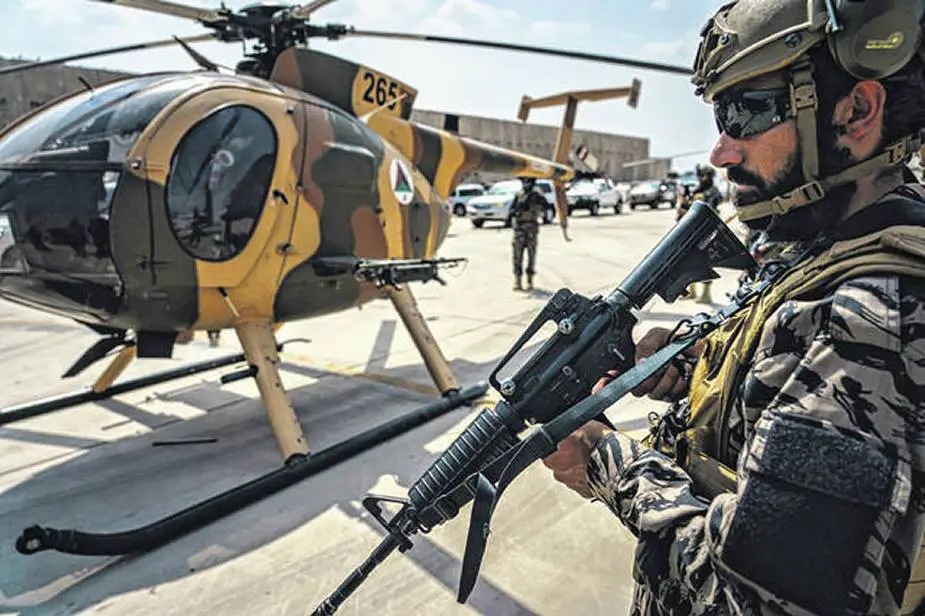Transfers of major arms to Afghanistan between 2001 and 2020 (SIPRI)
Twenty years of US-led international military presence in Afghanistan ended on 30 August 2021, with the withdrawal of the last foreign forces. Since 2001, significant numbers of major arms had been delivered to bolster the Afghan military and security forces, in the expectation that they would eventually be able to maintain security and suppress the Taliban insurgency without international support. It ended in a dramatic failure.
Follow Army Recognition on Google News at this link

Afghan National Army (ANA) students remove the turret on a US-supplied ASV-150/M-1117 armoured vehicle as part of maintenance training, 2013. (Picture source: Wikimedia Commons/SGT Kent Redmond)
In a SIPRI (Stockholm International Peace Reseach Institute) report, Alexandra Kuimova and Siemon T. Wezeman give an overview of known international flows of major arms to the Afghan armed forces between 2001 and 2020. The report discusses the supplier states, volumes, types and numbers of major arms deliveries. It does not cover deliveries of small arms and light weapons, which were also supplied to Afghanistan in large numbers.
All data come from the SIPRI Arms Transfers Database, which contains data on transfers of major arms (as defined by SIPRI) between 1950 and 2020. Volumes of arms deliveries are compared using SIPRI trend-indicator values.
Overview of transfers
In terms of volume, Afghanistan was not a very large recipient of major arms: in 2016–20 it ranked as only the 25th largest recipient in the world, accounting for 1.0 percent of the global total. Slightly over three-quarters of the major arms delivered, by volume, were newly produced, while the rest were second-hand, but in some cases modified prior to delivery. The volumes of major arms transfers to the Afghan armed forces grew significantly between 2001–2005 and 2011–2015. However, volumes decreased by 24 percent in 2016–2020.
Sixteen states are known to have supplied major arms to Afghanistan in the period 2001–2020. The major arms were overwhelmingly armored land vehicles and aircraft (airplanes and helicopters).
Transfers from the USA
The USA was the largest major arms supplier to Afghanistan in every consecutive five-year period after 2001–2005.
Between 2001 and 2020 the USA was the supplier for 74 percent of Afghanistan’s imports of major arms by volume. The volume of US transfers to Afghanistan increased between 2001–2005 and 2011–2015. During 2016–2020, the volume of US exports was similar to the previous five years, and it was twice as high as in 2006–2010 and around 65 times higher compared with 2001–2005. Also, by 2016–2020 imports from other states had fallen even more sharply, and the USA accounted for almost 90 percent of Afghanistan’s imports of major arms by volume.
Deliveries from the USA to Afghanistan from 2001 included an estimated 21 924 armored vehicles (e.g. HMMWV-UA, ASV-150/M-1117), 66 MD-530F armed light helicopters, 34 Cessna-208B armed light transport aircraft, and 53 UH-60A transport helicopters. The USA also delivered 65 ScanEagle (unarmed) unmanned aerial vehicles and an estimated 250 Paveway guided bombs. Most of the arms were supplied to Afghanistan as aid.

Afghanistan received 66 MD-530F armed light helicopters, now in the hands of the Talibans (Picture source: Twitter)
Transfers from Russia
Russia was the second-largest supplier of major arms to the Afghan armed forces in the period, accounting for 14 percent of imports, by volume. All of these deliveries took place between 2002 and 2014.
Deliveries from Russia mainly consisted of 90 second-hand and newly produced Mi-8MTV and Mi-17 transport helicopters between 2002 and 2014. Early deliveries (2002–2005) were in the form of aid, but most of the transport helicopters were bought via and financed by the USA in 2009–2014, and 10, which were delivered in 2010, were financed by the United Arab Emirates.
Transfers from other suppliers
Several other states, mainly North Atlantic Treaty Organization (NATO) member states, delivered smaller volumes of major arms to Afghanistan directly or supplied major arms through US-run and US-funded programmes.
Italy accounted for 3.8 percent of all deliveries of major arms to Afghanistan, by volume, in the period. These consisted of 16 second-hand G-222 transport aircraft in 2009–2012, financed by the USA. The aircraft were modernized in Italy before delivery.
Among other NATO member states and NATO partner states, Czechia supplied six Mi-24 combat helicopters and six Mi-17 transport helicopters in 2007–2009. All were second-hand but were modernized in Czechia before delivery, in a programme paid for by NATO. The United Kingdom supplied two Mi-17 transport helicopters in 2010; Bosnia and Herzegovina, Slovakia and Turkey supplied a total of 128 second-hand artillery pieces between 2006 and 2013; and Norway supplied an estimated 159 TOW anti-tank missiles in 2009. All these transfers came as direct aid or were financed by the USA.
Several non-NATO states also supplied major arms. Brazil was the fourth-largest supplier, accounting for 2.7 percent of all deliveries. These were 26 Super Tucano (A-29B) trainer/combat aircraft, delivered in 2016–2018. They were bought through a US programme, financed by the USA and modified in the USA before delivery to Afghanistan. They became the main combat aircraft of the Afghan air force.
Switzerland supplied 18 PC-12 light transport aircraft in 2015. These reached Afghanistan via the USA and were probably modified in the USA for reconnaissance before final delivery.
India supplied three Cheetal light helicopters and four second-hand Mi-25 combat helicopters in 2015–2016. It also financed the supply of four second-hand Mi-24V combat helicopters from Belarus in 2019.
Reflections
The Afghan military and security forces received a substantial number of major arms between 2001 and 2020, even if they were generally not very advanced systems. Despite this very substantial material investment, not to mention years of military training and combat support, the Taliban were able to seize most of Afghanistan from Afghan Government control in a matter of weeks, once NATO’s Resolute Support Mission terminated on 12 July.
One question is the effect the presence of these weapons will have on security and stability, both within and beyond Afghanistan’s borders.
Some of the major arms listed were subsequently lost or scrapped and others—mainly aircraft—were apparently used by Afghan forces in August 2021 to flee Afghanistan. However, a substantial number of the arms sent to bolster the Afghan armed forces have been captured by the Taliban. It is unclear how many of these are or can be made operational—many of the aircraft will need specialized maintenance and spare parts that are probably not easily available to the Taliban. Other, simpler to maintain, major arms such as the light armored vehicles can easily be operated for many years.
All in all, it seems unlikely that the major arms captured by the Taliban would pose any serious threat to stability in Afghanistan’s neighbors or further afield. However, the large numbers of small arms and light weapons and associated ammunition are potentially of much graver concern, Alexandra Kuimova and Siemon T. Wezeman conclude.


























